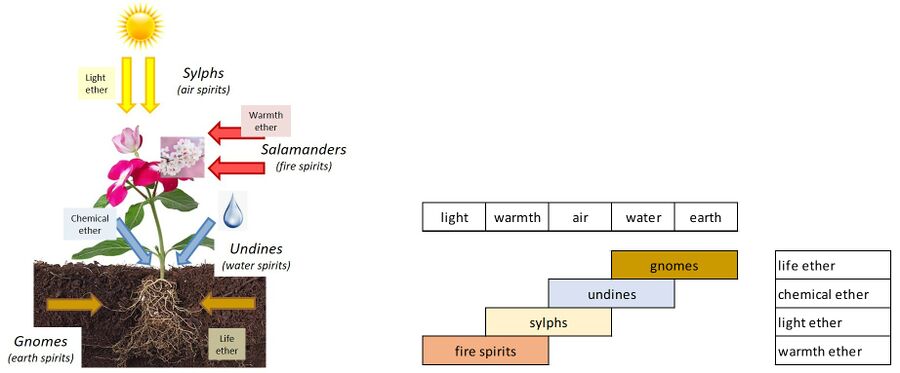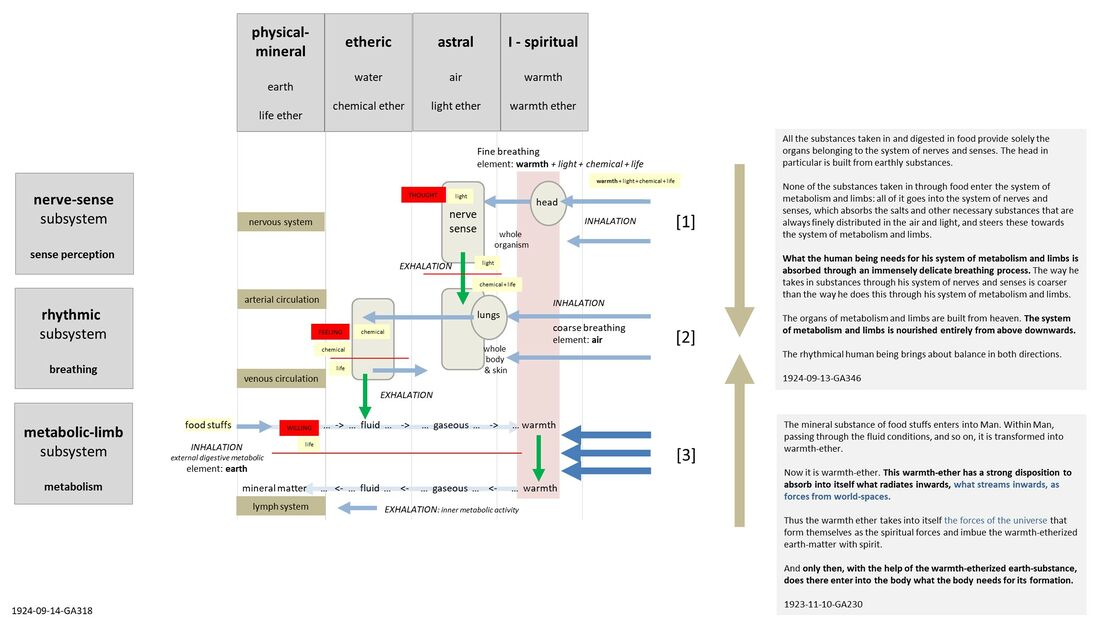Photosynthesis
Photosynthesis is the term used by mineral science to describe the process by which plants (green plants and certain other organisms) transform light energy into chemical energy for use in the organism's metabolic activities. More specifically the process whereby sunlight, water, minerals and carbon dioxide are transformed into oxygen and energy-rich organic compounds: the chemical energy is stored in sugars and starches that are synthesized from carbon dioxide and water – hence the name photosynthesis.
In spiritual science the full spectrum of elements and ethers is taken into consideration, because the plant is a living entity and not dead mineral matter, hence the processes that take place need to be explained by etheric formative forces and how these life forces interact with the living plant.
Hence it can be formulated broader as that, in the juice of the plant, photosynthesis makes for the interaction of light, warmth and physical substance (ie hydrogen, carbon dioxide, oxygen, nitrogen) to synthesize organic substances into proteins, fats and sugars.
Aspects
- See more on Plant kingdom, Overview on etheric research and the plant kingdom, Transmutation, and Biodynamic agriculture.
- the importance of the light ether metabolism that follows from breaking down proteins (see Pfeiffer below)
Illustrations
Schema FMC00.009A depicts that a plant doesn't just grow with water and sunshine. As a start, we can study the processes of photosynthesis (above the ground) and transmutation (under the ground). The first is accepted and studied in mineral science (though incompletely), the second currently not at all, resulting in an incomplete understanding.
In spiritual science the process is considered as the workings of spiritual beings, in this case the Elementals of nature, and the beings of The elementary kingdoms that are the forces behind the higher ethers.

Schema FMC00.195 illustrates the same as Schema FMC00.009A, now with BBD and lecture reference and extract:

Schema FMC00.412 uses the 1924-09-14-GA318 illustration FMC00.015A to overlay the workings of the metabolic system, that were not on the base FMC00.015A. Hence both schemas can be taken together. Note the FMC00.015A illustration logic does not quite fit the descriptions of the lecture extracts, to depict this would require other arrows, to compensate for this the red block of the warmth body was expanded to above.

Lecture coverage and references
1958-10-10- Ehrenfried. Pfeiffer
lecture 'Subnature and supernature in the physiology of plant and Man' (published 2005)
Regarding the light process, see Schema FMC00.412 above.
.. two processes take place, a darkness and a light process:
- the darkness process (night activity of the plant) leads to formation of starch and sugar. When sugar breaks down it releases warmth.
- a light process: When warmth is liberated, light comes free in the body. This light formation will occasion the formation of protein substances. protein is formed out of light. Enzymes give plants their capacity to combine these forces with mediating substances so protein can be build up. Enzymes contain phospor compounds (adenosine, tryptosine, etc). All substances in which phosphorous and to a small extent magnesium play a role. Note phosphor was called by the alchemist the carrier of light. Enzymes means or can be read as : 'tremendous transformation at tremendous speeds', they are key to metabolism and life, to health and youthfullness. Fats are formed in plants as a kind of enhancement of the sugar process: when the sugar process makes a somersault and connects several compounds, and then gets rid of some water, the fatty acids appear.
Now mineral science speaks about caloric energy of the combustion of sugar to carbohydrates that gives off warmth energy to the body, but doesn't speak of the light energy given off when proteins are digested under influence of enzymes (and warmth).
This is the important point: Light is absorbed, then liberated in digestion, and we receive light. When we have broken down the protein we receive the light which is released in the body and this has an extremely important effect: it is this that maintains life for the body, especially in the nerveous system (and the brain). When the light metabolism (ai phosphate enzyme transformation) is affected, it affects the life power as well as consciousness.
1958 - Pfeiffer
From the 1958 preface to the GA327 agriculture course.
.. [when I inspected Schultz's experiments, I was struck by the fact that] .. plants grown on the same nutrient solution had a wholly different substantial composition according to the light-rhythms operative. This was true of nitrogen, for example. Plants exposed to light during the morning and evening hours grew strongly under the favourable influence of nitrogen activity, whereas if exposed during the noon hours, they declined and showed deficiency symptoms. The way was thus opened for experimental demonstration of the fact that the so-called 'cosmic' activity of light, of warmth, of sun forces especially, but of other light-sources also, prevails over the material processes. These cosmic forces regulate the course of material change. When and in what direction this takes place, and the extent to which the total growth and the form of the plant are influenced, all depend upon the cosmic constellation and the origin of the forces concerned. Recent research in the field of photosynthesis has produced findings which can hardly fail to open the eyes even of materialistic observers to such processes. Here, too, Rudolf Steiner is shown to have been a pioneer who paved the way for a new direction of research. It is impossible in an article of this length to report on all the phenomena that have already been noted, for they would more than fill a book. But it is no longer possible to dismiss the influence of cosmic forces as 'mere superstition' when the physiological and biochemical inter-relationships of metabolic functions in soil-life, the rise and fall of sap in the plant, and especially processes in the root-sphere are taken into consideration.
Discussion
Related pages
- Plant kingdom
- Metabolic-limb subsystem
- Transmutation
- Formative forces
- Spectrum of elements and ethers
- Biodynamic agriculture
- Overview on etheric research and the plant kingdom
References and further reading
- Ehrenfried Pfeiffer: 'Subnature and supernature in the physiology of plant and man', lecture on 10 Oct 1958 (published 2005)
